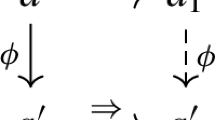Abstract
Rippling is a type of rewriting developed for inductive theorem proving that uses annotations to direct search. Rippling has many desirable properties: for example, it is highly goal directed, usually involves little search, and always terminates. In this paper we give a new and more general formalization of rippling. We introduce a simple calculus for rewriting annotated terms, close in spirit to first-order rewriting, and prove that is has the formal properties desired of rippling. Next we develop criteria for proving the termination of such annotated rewriting, and introduce orders on annotated terms that lead to termination. In addition, we show how to make rippling more flexible by adapting the termination orders to the problem domain. Our work has practical as well as theoretical advantages: it has led to a very simple implementation of rippling that has been integrated in the Edinburgh CLAM system.
Similar content being viewed by others
Explore related subjects
Discover the latest articles, news and stories from top researchers in related subjects.References
Basin, David and Walsh, Toby: Difference unification, in Proc. 13th IJCAI, International Joint Conference on Artificial Intelligence, 1993, pp. 116–122.
Basin, David and Walsh, Toby: Termination orderings for rippling, in Proc. 12th Int. Conf. Automated Deduction (CADE-12), Nancy, France, June 1994, Springer-Verlag.
Biundo, Susanne, Hummel, Birgit, Hutter, Dieter, and Walther, Christoph: The Karlsruhe induction theorem proving system, in 8th Int. Conf. Automated Deduction, Oxford, UK, 1986.
Boyer, Robert S. and Moore, J Strother: A Computational Logic. Academic Press, 1979.
Bundy, Alan, vanHarmelen, Frank, Hesketh, Jane, and Smaill, Alan: Experiments with proof plans for induction, J. Automated Reasoning 7 (1991), 303–324.
Bundy, Alan, Stevens, Andrew, vanHarmelen, Frank, Ireland, Andrew, and Smaill, Alan: Rippling. A heuristic for guiding inductive proofs, Artificial Intelligence 62 (1993), 185–253.
Bundy, Alan, van Harmelen, Frank, Horn, Christian, and Smaill, Alan: The Oyster-Clam system, in M. E. Stickel (ed.), 10th Int. Conf. Automated Deduction, Lecture Notes in Artificial Intelligence 449, Springer-Verlag, 1990, pp. 647–648.
Bundy, Alan, van Harmelen, Frank, Smaill, Alan, and Ireland Andrew: Extensions to the rippling-out tactic for guiding inductive proofs, in M. E. Stickel (ed.), 10th Int. Conf. Automated Deduction, Lecture Notes in Artificial Intelligence 449, Springer-Verlag, 1990, pp. 132–146.
Bundy, Alan and Welham, Bob: Using meta-level inference for selective application of multiple rewrite rules in algebraic manipulation, Artifical Intelligence 16(2) (1981), 189–212.
Cleve, Jürgen and Hutter, Dieter: A methodology for equational reasoning, in HICSS-27, IEEE, 1994.
Dershowitz, Nachum: Termination of rewriting, in J.-P. Jouannaud (ed.), Rewriting Techniques and Applications, Academic Press, 1987, pp. 69–116.
Dershowitz, Nachum: Orderings for term-rewriting systems, Theor. Computer Science 17(3) (March 1982), 279–301.
Hutter, Dieter: Colouring terms to control equational reasoning, an expanded version of PhD Thesis: Mustergesteuerte Strategien für Beweisen von Gleichheiten, Universität Karlsruhe, 1991.
Hutter, Dieter: Guiding inductive proofs, in M. E. Stickel (ed.), 10th Int. Conf. Automated Deduction, Lecture Notes in Artificial Intelligence 449, Springer-Verlag, 1990, pp. 147–161.
Ireland, Andrew and Bundy, Alan: Productive use of failure in inductive proof, J. Automated Reasoning 16(1–2) (1996) 79–111.
Walsh, Toby, Nunes, Alex and Bundy, Alan: The use of proof plans to sum series, in D. Kapur (ed.), 11th Conf. Automated Deduction, Lecture Notes in Computer Science 607, Springer-Verlag, 1992, pp. 325–339.
Yoshida, Tetsuja, Bundy, Alan, Green, Ian, Walsh, Toby, and Basin, David: Coloured rippling: An extension of a theorem proving heuristic, in ECAI-94, Wiley, New York, 1994.
Author information
Authors and Affiliations
Additional information
Funded by the German Ministry for Research and Technology under grant ITS 9102.
Supported by a Human Capital and Mobility Research Fellowship from the European Commission. Both authors thank members of the Edinburgh Mathematical Reasoning Group, as well as Alan Bundy, Leo Bachmair, Dieter Hutter, and Michael Rusinowitch, for their comments on previous drafts. Additional support was also received from the MInd grant EC-US 019-76094.
Rights and permissions
About this article
Cite this article
Basin, D.A., Walsh, T. A calculus for and termination of rippling. J Autom Reasoning 16, 147–180 (1996). https://doi.org/10.1007/BF00244462
Issue Date:
DOI: https://doi.org/10.1007/BF00244462




